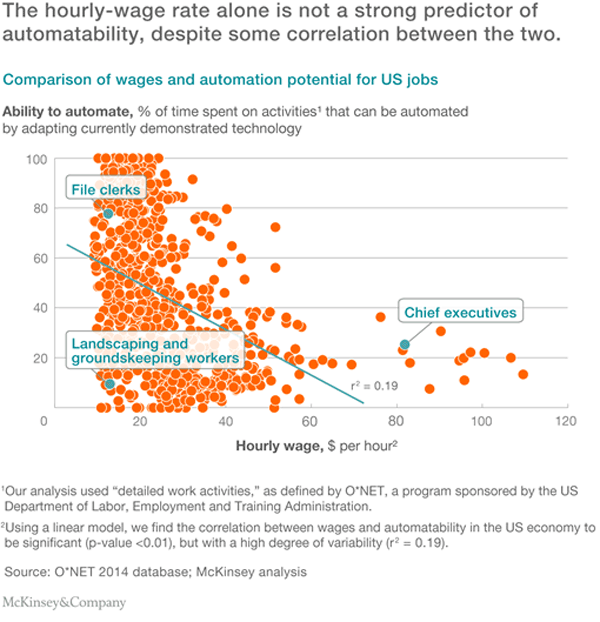Four fundamentals of workplace automation

As the automation of physical and knowledge work advances, many jobs will be redefined rather than eliminated—at least in the short term, according to Michael Chui, James Manyika, and Mehdi Miremadi, analysts at the McKinsey Global Institute in Chicago
The potential of artificial intelligence and advanced robotics to perform tasks once reserved for humans is no longer reserved for spectacular demonstrations by the likes of IBM’s Watson, Rethink Robotics’ Baxter, DeepMind, or Google’s driverless car.
Just head to an airport: automated check-in kiosks now dominate many airlines’ ticketing areas. Pilots actively steer aircraft for just three to seven minutes of many flights, with autopilot guiding the rest of the journey. Passport-control processes at some airports can place more emphasis on scanning document bar codes than on observing incoming passengers.
What will be the impact of automation efforts like these, multiplied many times across different sectors of the economy? Can we look forward to vast improvements in productivity, freedom from boring work, and improved quality of life? Should we fear threats to jobs, disruptions to organizations, and strains on the social fabric?
Earlier this year, we launched research to explore these questions and investigate the potential that automation technologies hold for jobs, organizations, and the future of work. Our results to date suggest, first and foremost, that a focus on occupations is misleading. Very few occupations will be automated in their entirety in the near or medium term. Rather, certain activities are more likely to be automated, requiring entire business processes to be transformed, and jobs performed by people to be redefined, much like the bank teller’s job was redefined with the advent of ATMs.
More specifically, our research suggests that as many as 45 percent of the activities individuals are paid to perform can be automated by adapting currently demonstrated technologies (for more, explore our interactive examining the potential for US jobs to be automated, on Tableau Public). In the United States, these activities represent about $US2 trillion in annual wages. Although we often think of automation primarily affecting low-skill, low-wage roles, we discovered that even the highest-paid occupations in the economy, such as financial managers, physicians, and senior executives, including CEOs, have a significant amount of activity that can be automated.
The organizational and leadership implications are enormous: leaders from the C-suite to the front line will need to redefine jobs and processes so that their organizations can take advantage of the automation potential that is distributed across them. And the opportunities extend far beyond labour savings. When we modelled the potential of automation to transform business processes across several industries, we found that the benefits (ranging from increased output to higher quality and improved reliability, as well as the potential to perform some tasks at superhuman levels) typically are between three and ten times the cost. The magnitude of those benefits suggests that the ability to staff, manage, and lead increasingly automated organizations will become an important competitive differentiator.
Our research is ongoing, and in 2016, we will release a detailed report. What follows here are four interim findings elaborating on the core insight that the road ahead is less about automating individual jobs wholesale, than it is about automating the activities within occupations and redefining roles and processes.

Continue reading at http://www.mckinsey.com/insights/business_technology/four_fundamentals_of_workplace_automation
